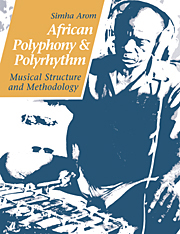Book contents
- Frontmatter
- Contents
- List of illustrations
- Foreword by György Ligeti
- Preface
- Acknowledgements
- BOOK I THE MUSIC OF THE CENTRAL AFRICAN REPUBLIC
- BOOK II AFRICAN POLYPHONIC MUSIC
- Introduction
- 1 A classification of African polyphonies
- 2 Previous studies: the present state of the subject
- BOOK III TECHNICAL TOOLS: METHODS OF RECORDING POLYPHONIC MUSIC FOR TRANSCRIPTION
- BOOK IV THEORETICAL TOOLS
- BOOK V THE ORGANISATION OF TIME IN AFRICAN MUSIC
- BOOK VI STRUCTURAL PRINCIPLES AND THEIR APPLICATION
- Conclusion
- Bibliography
Introduction
Published online by Cambridge University Press: 27 January 2010
- Frontmatter
- Contents
- List of illustrations
- Foreword by György Ligeti
- Preface
- Acknowledgements
- BOOK I THE MUSIC OF THE CENTRAL AFRICAN REPUBLIC
- BOOK II AFRICAN POLYPHONIC MUSIC
- Introduction
- 1 A classification of African polyphonies
- 2 Previous studies: the present state of the subject
- BOOK III TECHNICAL TOOLS: METHODS OF RECORDING POLYPHONIC MUSIC FOR TRANSCRIPTION
- BOOK IV THEORETICAL TOOLS
- BOOK V THE ORGANISATION OF TIME IN AFRICAN MUSIC
- BOOK VI STRUCTURAL PRINCIPLES AND THEIR APPLICATION
- Conclusion
- Bibliography
Summary
This second Book is divided into two parts. In the first I attempt a classification of African polyphony, and in the second I consider the present state of the subject, in the light of previous studies. My approach to Central African polyphony is based upon fieldwork, and upon initially empirical and always pragmatic observations of the various musical procedures current in a specific geographical area.
It might have seemed more logical to begin with a summary of previous discussions before attempting a classification of these musical procedures. The reason which led me to adopt a different approach is the following one: a summary of the problem could not be attempted until one had defined more exactly what this ‘problem’ was, or, in other words, what the term polyphony could be taken to mean here.
The first part of this book is devoted to a classification of modalities of organisation, because it was this that enabled me to distinguish, out of all the types of multi-part musics observed, those which ought to be considered polyphonic. The second part, on the other hand, is a survey of historical records and of all the specialised modern treatments of African polyphony – such as will be defined below – to which I had access. So my approach, while basically synchronic, does nevertheless enable the diachronic aspect to be considered. This other, historical, point of view does indeed lead to an important observation: namely that a number of the musical procedures that are to be found today in an apparently restricted cultural area are not only still quite widespread in Africa today, but were equally widespread as far back as we have reliable testimonies, that is, up to nearly five hundred years ago.
- Type
- Chapter
- Information
- African Polyphony and PolyrhythmMusical Structure and Methodology, pp. 33Publisher: Cambridge University PressPrint publication year: 1991
- 1
- Cited by

